Michael J. Behe's Blog, page 41
September 7, 2022
At Sci News: Brasilodon is Earliest Known Mammal, New Research Shows
Paleontologists have examined the fossilized lower jaws of Brasilodon quadrangularis, a mouse-sized creature that lived in Brazil during the Late Triassic epoch, some 225 million years ago. The analysis of the different growth stages showing tooth development in each of the Brasilodon fossils provided evidence that these were the remains of a mammal. Previously, the earliest accepted record in geological time of mammals was 205 million years ago.
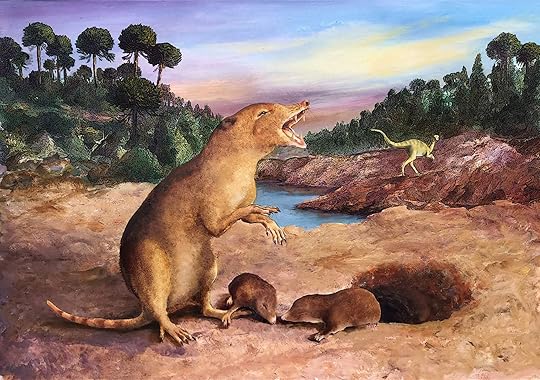 Brasilodon quadrangularis was approximately 12 cm (8 inches) long and weighed about 20 grams. The animal existed at the same time as the earliest known dinosaurs and probably lived in burrows like the shrews today. Image credit: Anatomical Society / Wiley.
Brasilodon quadrangularis was approximately 12 cm (8 inches) long and weighed about 20 grams. The animal existed at the same time as the earliest known dinosaurs and probably lived in burrows like the shrews today. Image credit: Anatomical Society / Wiley.
Mammalian glands, which produce milk and feed the young of mammals today, have not been preserved in any fossils found to date.
Therefore, scientists have had to rely on fossilized bone and teeth for alternative clues.
The dental records date 225 million years ago, 25 million years after the Permian-Triassic mass extinction event that led to the extinction of roughly 70% of terrestrial vertebrate families.
Mass extinction events provided an opportunity for new types of fauna to multiply, but the scientific evidence on the limitations of natural processes indicate that the appearance of new class of animals requires the input of intelligent design.
A tiny animal called Morganucodon is usually considered the first mammal but its oldest fossils, only represented by isolated teeth, date from around 205 million years ago.
“Comparative studies with recent mammal dentitions and tooth replacement modes suggest that Brasilodon was a placental, relatively short-lived animal,” Dr. Richter said.
Copyright © 2022 Uncommon Descent . This Feed is for personal non-commercial use only. If you are not reading this material in your news aggregator, the site you are looking at is guilty of copyright infringement UNLESS EXPLICIT PERMISSION OTHERWISE HAS BEEN GIVEN. Please contact legal@uncommondescent.com so we can take legal action immediately.“Dated at 225.42 million years old, this is the oldest known mammal in the fossil record contributing to our understanding of the ecological landscape of this period and the evolution of modern mammals.”
“The evidence from how the dentition was built over developmental time is crucial and definitive to show that brasilodons were mammals,” added Professor Moya Meredith Smith, a researcher at King’s College London.
“Our paper raises the level of debate about what defines a mammal and shows that it was a much earlier time of origin in the fossil record than previously known.”
The paper appears this week in the Journal of Anatomy.
Full article at Sci News.
Plugin by Taragana
September 6, 2022
At Phys.org: New breakthrough pushes perovskite cell to greater stability, efficiency
Researchers at the U.S. Department of Energy’s (DOE’s) National Renewable Energy Laboratory (NREL) have made a technological breakthrough and constructed a perovskite solar cell with the dual benefits of being both highly efficient and highly stable.
 The inverted architecture of this perovskite solar cell, coupled with surface engineering, enabled researchers to improve efficiency and stability. Credit: NREL
The inverted architecture of this perovskite solar cell, coupled with surface engineering, enabled researchers to improve efficiency and stability. Credit: NREL
The work was done in collaboration with scientists from the University of Toledo, the University of Colorado-Boulder, and the University of California-San Diego.
A unique architectural structure enabled the researchers to record a certified stabilized efficiency of 24% under 1-sun illumination, making it the highest reported of its kind. The highly efficient cell also retained 87% of its original efficiency after 2,400 hours of operation at 55 degrees Celsius.
Perovskite, which refers to a crystalline structure, has emerged in the last decade as an impressive means to efficiently capture sunlight and convert it to electricity. Research into perovskite solar cells has been focused to a large degree on how to increase their stability.
“Some people can demonstrate perovskites with high stability, but efficiency is lower,” said Zhu, a senior scientist in the Chemistry and Nanoscience Center at NREL. “You ought to have high efficiency and high stability simultaneously. That’s challenging.”
The researchers used an inverted architecture, rather than the “normal” architecture that has to date yielded the highest efficiencies. The difference between the two types is defined by how the layers are deposited on the glass substrate. The inverted perovskite architecture is known for its high stability and integration into tandem solar cells.
The NREL-led team also added a new molecule, 3-(Aminomethyl) pyridine (3-APy), to the surface of the perovskite. The molecule reacted to the formamidinium within the perovskite to create an electric field on the surface of the perovskite layer.
“That suddenly gave us a huge boost of not only efficiency but also stability,” Zhu said.
The scientists reported the 3-APy reactive surface engineering can improve the efficiency of an inverted cell from less than 23% to greater than 25%. They also noted the reactive surface engineering stands out as an effective approach to significantly enhance the performance of inverted cells “to new state-of-the-art levels of efficiency and operational reliability.”
Phys.org
One of the examples of “prior environmental fitness” that Michael Denton noted in his book, The Miracle of Man, is that the Earth’s crust contains accessible amounts of exotic materials that have found unique applications in our technological advancements.
Copyright © 2022 Uncommon Descent . This Feed is for personal non-commercial use only. If you are not reading this material in your news aggregator, the site you are looking at is guilty of copyright infringement UNLESS EXPLICIT PERMISSION OTHERWISE HAS BEEN GIVEN. Please contact legal@uncommondescent.com so we can take legal action immediately.Plugin by Taragana
At Reasons.org: Do the James Webb Telescope Images Show the Big Bang Didn’t Happen?
Astrophysicist Jeff Zweerink provides an updated analysis:
The James Webb Space Telescope (JWST) is just starting to reveal images of the universe never seen before. The amazing clarity of this new telescope will help scientists better understand how the universe developed from the big bang until now. However, one claim based on some of the early images generated controversy, and quite a bit of publicity. Specifically, physicist and science writer Eric Lerner argued that the JWST shows the big bang didn’t happen! Let’s unpack that claim to see how to respond.
 Reasons.org
Reasons.org
Eric Lerner’s Plasma Cosmology
Eric Lerner’s claim is nothing new. In fact, he articulated his claim 30 years ago in his book The Big Bang Never Happened: A Startling Refutation of the Dominant Theory of the Origin of the Universe! Instead of gravity driving the large-scale dynamics of the universe (as in big bang cosmology), Lerner’s plasma cosmology has electromagnetic forces dominating. According to Lerner, if plasma physics governs the formation of galaxies, stars, and all the features of the universe, the universe would have no beginning. And Lerner asserts that the big bang add-ons of dark matter and dark energy are unnecessary in his model.
As one might expect, the scientific community responded by acknowledging and addressing both the data Lerner used to argue against big bang cosmology as well as the evidence used to support his model. For one example of such a response, see this analysis by a colleague of mine from UCLA. Though last updated back in 2003, the criticisms of Lerner’s cosmology still apply today.
How Does JWST Impact the Discussion?
Lerner’s recent statements argue that the new JWST images refute the big bang and match the predictions of his plasma cosmology. However, we need to exercise caution. The strongest evidence for big bang cosmology arises from observations of the cosmic microwave background (CMB) radiation (by COBE, WMAP, Planck, and others) and from measurements of the distance/redshift relationship obtained by observing galaxies throughout the universe. None of the JWST images impact this evidence!
First, JWST was not designed—and has no capacity—to observe the CMB. Second, JWST was designed to investigate distant galaxies at high redshift to study their properties. None of the current JWST data undermines the copious evidence that redshift systematically increases with distance. JWST has found some distant galaxies that are larger and more developed than expected in many big bang models. Lerner claims these galaxy observations invalidate big bang models while matching predictions of his plasma cosmology.
Is the Big Bang Dead?
One should remember that these types of discrepancies occur rather frequently in science. For most of the 1970s, 80s, and into the 90s, astronomers couldn’t even agree whether the universe was closer to 10 billion years old or 20 billion years old because different measurement techniques gave different ages! During my scientific career, I have read published papers with star dates older than the age of the universe, cosmic structures too large to form given the universe’s age, and measurements showing the CMB as too smooth to form stars, galaxies, and clusters of galaxies. Interestingly, that last item was part of the evidence that prompted Lerner to develop his alternative cosmology model. Yet, in every example just listed, further research by the scientific community resulted in a better, more precise understanding of big bang cosmology.
Other times, resolving one inconsistency leads to a previously unknown discrepancy. For example, we now know that the universe is 13.8 billion years old. Calculations based on the redshift/distance relationship provide that age of 13.8 billion years, but an analysis of the CMB ripples gives dates closer to 12.5 billion years. Given the copious evidence in support of big bang models, scientists welcome these discrepancies since they provide useful direction for future research to understand our big-bang universe in more detail!
One Final Thought on Alternative Models
Scientists routinely produce alternative models like Eric Lerner’s. Even with the tremendous experimental success of general relativity, a number of scientists favor a different approach known as MOND, where they modify Newtonian dynamics. Often MOND and GR (general relativity) calculations can both explain the data produced by observations of the universe. The fact that MOND solves the dark matter or dark energy problem by making them unnecessary makes MOND attractive to many scientists. That solution comes at the expense of MOND not providing a mechanism for explaining why gravity works. General relativity provided that mechanism as arising from the curvature of spacetime. Thus, for most scientists MOND introduces a larger problem than it solves.
Lerner’s plasma cosmology suffers a similar problem. Even if plasma cosmology predicted the CMB as well as the galaxy shapes and clustering and evolution with equal proficiency to big bang cosmology, it offers no workable explanation for the well-established redshift/distance relationship. Big bang cosmology provides a simple explanation—the universe is expanding.
The latest JWST images don’t justify the enormous attention Lerner’s model has recently received in the public sphere. Yet, Lerner’s plasma cosmology deserves a place at the table of models trying to explain our universe. Science advances when theory matches observation.
Full article available at Reasons to Believe.
Hannes Alfvén, who won the Nobel Prize in physics in 1970, for his work on plasma magnetohydrodynamics, affirmed that galactic-scale magnetic and electric fields affected the structural organization of matter (plasma). While plasma effects most likely play a role, the role of gravity as understood by the tightly confirmed theory of general relativity, appears to be dominant. As Dr. Zweerink emphasizes, discrepancies between theory and observation provide motivation for refinement of both.
Copyright © 2022 Uncommon Descent . This Feed is for personal non-commercial use only. If you are not reading this material in your news aggregator, the site you are looking at is guilty of copyright infringement UNLESS EXPLICIT PERMISSION OTHERWISE HAS BEEN GIVEN. Please contact legal@uncommondescent.com so we can take legal action immediately.Plugin by Taragana
Yockey reminds us on code use in Protein Synthesis
There is need to correct for record, given attempts to dismiss.
Note, Yockey’s diagram:
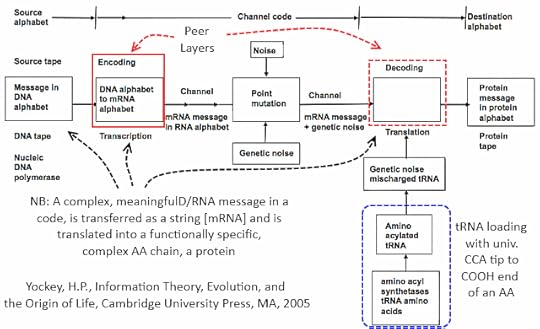 Yockey’s analysis of protein synthesis as a code-based communication process
Yockey’s analysis of protein synthesis as a code-based communication processWhere, we can observe on tRNA structure and action:
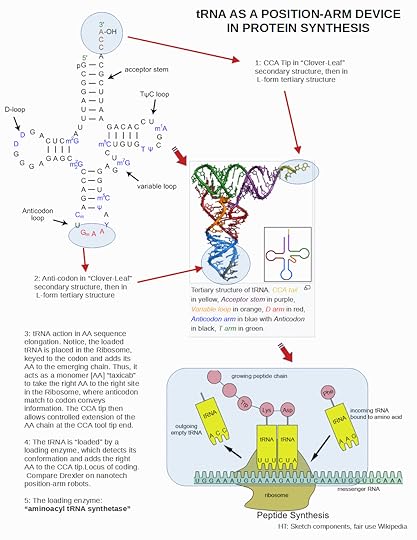
The presence of a universal, CCA tool-tip means, chemically, any tRNA could bind the COOH end of any AA, where basic AA structure is:
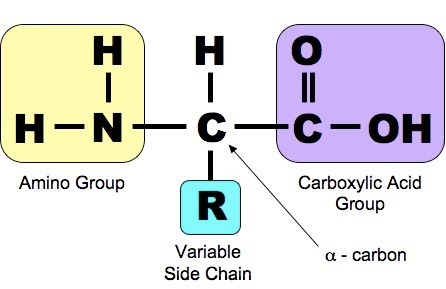
Given hyperskeptical objections, we need to emphasise that it is in fact uncontroversial consensus that the genetic code is just that, an actual code. As in:
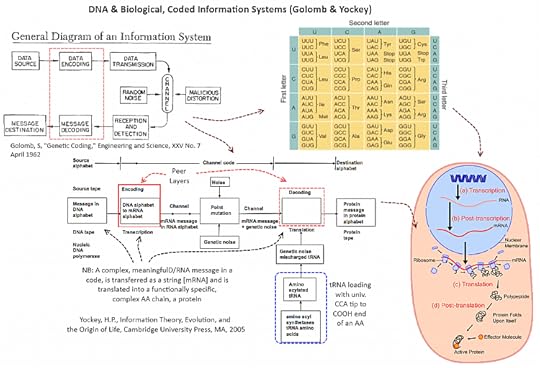
U/D Sept 6: Let us compare the ASCII code, which uses seven element strings b7 . . . b1, with two states per character bx [bases have four states per character, so Codons have 64 states], showing how a commonplace communication code is structured . . . directly comparable:
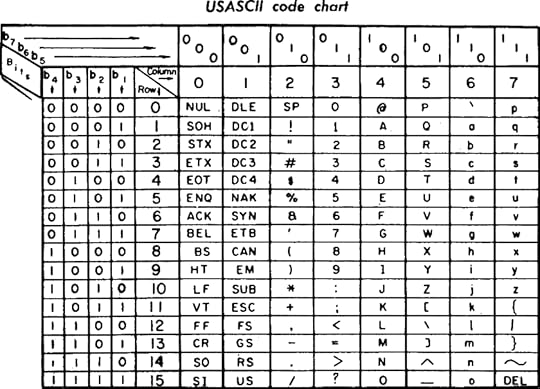
Lehninger being a justly famed reference and text on Biochem [an extension of Organic Chemistry], let us duly note:
“The information in DNA is encoded in its linear (one-dimensional) sequence of deoxyribonucleotide subunits . . . . A linear sequence of deoxyribonucleotides in DNA codes (through an intermediary, RNA) for the production of a protein with a corresponding linear sequence of amino acids . . . Although the final shape of the folded protein is dictated by its amino acid sequence, the folding of many proteins is aided by “molecular chaperones” . . . The precise three-dimensional structure, or native conformation, of the protein is crucial to its function.” [Principles of Biochemistry, 8th Edn, 2021, pp 194 – 5. Now authored by Nelson, Cox et al, Lehninger having passed on in 1986. Attempts to rhetorically pretend on claimed superior knowledge of Biochemistry, that D/RNA does not contain coded information expressing algorithms using string data structures, collapse. We now have to address the implications of language, goal directed stepwise processes and underlying sophisticated polymer chemistry and molecular nanotech in the heart of cellular metabolism and replication.]
For record. END
Copyright © 2022 Uncommon Descent . This Feed is for personal non-commercial use only. If you are not reading this material in your news aggregator, the site you are looking at is guilty of copyright infringement UNLESS EXPLICIT PERMISSION OTHERWISE HAS BEEN GIVEN. Please contact legal@uncommondescent.com so we can take legal action immediately.Plugin by Taragana
September 5, 2022
At Phys.org: Discovery of new types of microfossils may answer age-old scientific question
Scientists have long pondered how and when the evolution of prokaryotes to eukaryotes occurred. A collaborative research team from Tohoku University and the University of Tokyo may have provided some answers after discovering new types of microfossils dating 1.9 billion years.
Details of their findings were published in the journal Precambrian Research on August 19, 2022.
The Gunflint Formation traverses the northern part of Minnesota into Ontario, along the northwestern shores of Lake Superior. The first bacterial microfossils were discovered there in 1954, with Gunflint microfossils now recognized as a “benchmark” in the field of life evolution.
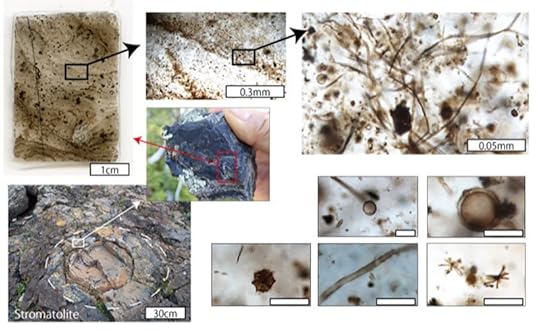 Common types of Gunflint microfossils, with white scale bars at a scale of 0.01mm. Credit: Sasaki et al.
Common types of Gunflint microfossils, with white scale bars at a scale of 0.01mm. Credit: Sasaki et al.
Yet, since the 1970s, little research on the diversity of Gunflint microfossils has been conducted, and no conclusive evidence of eukaryotic microfossils has been reported.
Seeking to reassess the microfossils, the research team carried out a geological survey of the Gunflint Formation and collected microfossil-containing rocks. After investigating the microfossils’ three-dimensional shape and size distribution, they unearthed five types of microfossils: colonial, ellipsoidal, intracellular inclusion-bearing (ICI), spinous and tail-bearing types.
“The newly found ones are more functional,” said the leader of the team Kohei Sasaki, a research fellow at Tohoku University. “The ellipsoidal microfossils resemble modern cyanobacteria, which evolved to improve their tolerance to harsh environments; whereas chemical analysis showed that the ICI microfossils were packed with nutrients.”
This provides evidence that the microorganisms evolved to store nutrients that could weather environmental stress.
Meanwhile, the spinous and tail-bearing types demonstrated features advantageous for motility and nutrient transfer among cells, a typical morphological feature of eukaryotes.
“Although the size of cells is prokaryote by definition, they had already developed eukaryotic functions,” added Sasaki. This indicates that prokaryotes may have begun diversifying their functions and preparing for evolution before the emergence of eukaryotes 1.8–1.6 billion years ago.
The team speculates that the unique environment at the time facilitated the divergent expansion of microbial forms. The collision of land masses accelerated oxidative weathering from the fresh continent to the ocean. This increased the nutrient supplies and raised seawater temperatures, making the marine environment unstable.
“Under such conditions, microorganisms probably diversified their morphology as a survival strategy, paving the way for eukaryotes to evolve,” continued Sasaki.
Sasaki and his team’s landmark discovery will help scientists pinpoint the timing and factors that ushered in the evolution of prokaryotes to eukaryotes, providing not only geological significance, but aiding the fields of life sciences and evolutionary biology as well.
Phys.org
The evolutionary worldview leads researchers to uncritically ascribe any changes in the fossil record to adaptation via evolution. But hasn’t research shown (as summarized in Brian Miller’s recent ENV post) that chance mutations are insufficient to produce novel, functional biomolecules found within the putative adaptations?
Copyright © 2022 Uncommon Descent . This Feed is for personal non-commercial use only. If you are not reading this material in your news aggregator, the site you are looking at is guilty of copyright infringement UNLESS EXPLICIT PERMISSION OTHERWISE HAS BEEN GIVEN. Please contact legal@uncommondescent.com so we can take legal action immediately.Plugin by Taragana
September 4, 2022
Appreciating Design and Designer – Vern Poythress
Philip Cunningham draws our attention to this:
https://www.youtube.com/watch?v=ReATRww8jVc
Rev. Dr. Vern Poythress (PhD, Harvard; DTh, Stellenbosch) is distinguished professor of New Testament, biblical interpretation, and systematic theology at Westminster Theological Seminary. His books include Redeeming Science, Redeeming Mathematics, and Redeeming Philosophy, or Chance and the Sovereignty of God.
Of related note, he adds:
A Biblical View of Mathematics – Vern Poythress – Doctorate in theology, PhD in Mathematics (Harvard) Excerpt: 15. Implications of Gödel’s proofB. Metaphysical problems of anti-theistic mathematics: unity and plurality
Excerpt: Because of the above difficulties, anti-theistic philosophy of mathematics is condemned to oscillate, much as we have done in our argument, between the poles of a priori knowledge and a posteriori knowledge. Why? It will not acknowledge the true God, wise Creator of both the human mind with its mathematical intuition and the external world with its mathematical properties. In sections 22-23 we shall see how the Biblical view furnishes us with a real solution to the problem of “knowing” that 2 + 2 = 4 and knowing that S is true.
Copyright © 2022 Uncommon Descent . This Feed is for personal non-commercial use only. If you are not reading this material in your news aggregator, the site you are looking at is guilty of copyright infringement UNLESS EXPLICIT PERMISSION OTHERWISE HAS BEEN GIVEN. Please contact legal@uncommondescent.com so we can take legal action immediately.Plugin by Taragana
September 3, 2022
Simon Conway Morris on his new book on Evolution, Convergence, and Theism
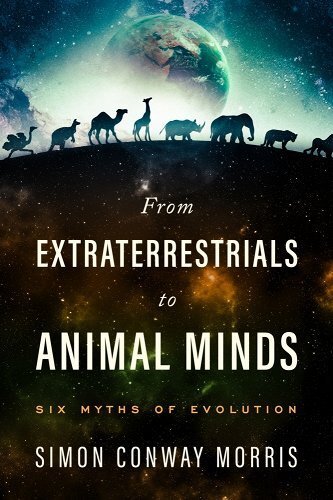
Palaeobiologist Simon Conway Morris discusses these topics with Sean Carroll in a Preposterous Universe: podcast.
Evolution by natural selection is one of the rare scientific theories that resonates within the wider culture as much as it does within science. But as much as people know about evolution, we also find the growth of corresponding myths. Simon Conway Morris is a paleontologist and evolutionary biologist who’s new book is From Extraterrestrials to Animal Minds: Six Myths of Evolution. He is known as a defender of evolutionary convergence and adaptationism — even when there is a mass extinction, he argues, the resulting shake-up simply accelerates the developments evolution would have made anyway. We talk about this, and also about the possible role of God in an evolutionary worldview.
A transcript is available.
Copyright © 2022 Uncommon Descent . This Feed is for personal non-commercial use only. If you are not reading this material in your news aggregator, the site you are looking at is guilty of copyright infringement UNLESS EXPLICIT PERMISSION OTHERWISE HAS BEEN GIVEN. Please contact legal@uncommondescent.com so we can take legal action immediately.Plugin by Taragana
Do courts (or smart people) trust Wikipedia?
Laughable idea. At Mind Matters News: Can you trust Wikipedia to decide your courtroom fate?
Should judges and lawyers rely on Wikipedia to guide court case decisions? Researchers devised clever test to see if they do. Meanwhile, U.S. courts have brushed it off:
The convenience of Wikipedia for quick searches via voice or keyboard input does not mean its information is accurate, reliable, or trustworthy. Wisely, many U.S. courts have tamed the impulse to resort to the Wikipedia shortcut. Some writers still push to elevate Wikipedia’s status as a truth source — hopefully the courts will never surrender to the notion of “democratic” truth posted by unknown wikiphiles.
Richard W. Stevens, “Can you trust Wikipedia to decide your courtroom fate?” at Mind Matters News
Wikipedia’s misrepresentations of ID may well be a norm, not an exception.
Takehome: Generally, American courts have pointedly — and very advisedly — rejected any reliance on Wikipedia as a source of facts in the courtroom.
You may also wish to read: Wikipedia’s bias meets a free-speech alternative. The famously free encyclopaedia’s pages on abortion, communism, and historical figures reveal a left-leaning bias. Wikipedia’s neutral point of view “is dead”, declares co-founder Larry Sanger, who is now launching a free-speech alternative.
Copyright © 2022 Uncommon Descent . This Feed is for personal non-commercial use only. If you are not reading this material in your news aggregator, the site you are looking at is guilty of copyright infringement UNLESS EXPLICIT PERMISSION OTHERWISE HAS BEEN GIVEN. Please contact legal@uncommondescent.com so we can take legal action immediately.Plugin by Taragana
Templeton offers a review of the extended evolutionary synthesis
—
Extended Evolutionary Synthesis: A review of the latest scientific research
By Lynn Chiu
Department of Evolutionary Biology
University of Vienna
This review—intended for curious readers, reporters, researchers, and teachers—is a road map to navigate rapidly moving terrain. To understand the direction of emerging research today, we need to ask: What happened to evolutionary biology during the 20th century and what did it leave out? Why is the Extended Evolutionary Synthesis seeking a more inclusive approach to evolutionary theorizing? And finally, what does a comprehensive evolutionary theory look like?
The review proceeds in three parts: examining the genetic turn of evolutionary theory since Darwin (Part 1); sampling multiple, independent calls for an alternative outlook (Part 2); and finally, taking a close look at the emerging structure and outcomes of an Extended Evolutionary Synthesis research program (Part 3).
—
But, to the extent that Darwinism is all-sufficient, the Extended Evolutionary Synthesis, pioneered by Stephen Jay Gould and Niles Eldredge attempts to solve a problem that doesn’t — in theory — exist … But, if it DOES exist…
Copyright © 2022 Uncommon Descent . This Feed is for personal non-commercial use only. If you are not reading this material in your news aggregator, the site you are looking at is guilty of copyright infringement UNLESS EXPLICIT PERMISSION OTHERWISE HAS BEEN GIVEN. Please contact legal@uncommondescent.com so we can take legal action immediately.Plugin by Taragana
At Mind Matters News: Researchers find more ways that human and ape brains differ
Underlying the significant differences in brain — to say nothing of the vast difference in mind — is a genetic mystery… :
The Smithsonian National Museum of Natural History tells us that “While the genetic difference between individual humans today is minuscule – about 0.1%, on average – study of the same aspects of the chimpanzee genome indicates a difference of about 1.2%. The bonobo (Pan paniscus), which is the close cousin of chimpanzees (Pan troglodytes), differs from humans to the same degree. The DNA difference with gorillas, another of the African apes, is about 1.6%. Most importantly, chimpanzees, bonobos, and humans all show this same amount of difference from gorillas. A difference of 3.1% distinguishes us and the African apes from the Asian great ape, the orangutan.” (August 15, 2022)
The differences between our brains and those of primates seem to be much greater than the genetic differences, so they don’t seem to originate in the genes. The mystery is perhaps analogous to that of the human mind.
News, “Researchers find more ways that human and ape brains differ” at Mind Matters News
Takehome: The differences between human brains and other primate brains seem greater than the 1.2% – 1.6% genetic difference the Smithsonian posits for humans vs. apes.
You may also wish to read: Your mind vs. your brain: Ten things to know
Copyright © 2022 Uncommon Descent . This Feed is for personal non-commercial use only. If you are not reading this material in your news aggregator, the site you are looking at is guilty of copyright infringement UNLESS EXPLICIT PERMISSION OTHERWISE HAS BEEN GIVEN. Please contact legal@uncommondescent.com so we can take legal action immediately.Plugin by Taragana
Michael J. Behe's Blog
- Michael J. Behe's profile
- 219 followers



